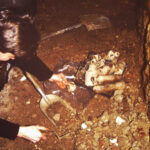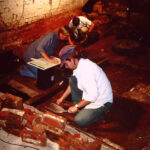Early Archaeology in South Australia
Although originating with scientists and untrained laymen, archaeology has a distinguished record in South Australia. The 1929 excavation at Devon Downs (Ngautngaut) on the River Murray north of Mannum was an Australian landmark in the recovery of the Aboriginal past. South Australian Museum officers Herbert Hale and Norman Tindale excavated through six metres of rock-shelter deposit and related the successive layers of faunal remains, stone and bone tools to environmental changes. Their detailed memoir demonstrated the potential of systematic stratigraphic investigation, yet its significance remained obscure until after the Great Depression and World War II. However, radiocarbon 14 dating of charcoal and shell from these samples proved the site’s occupation through 5000 years.
Tindale classified the artefacts and inferred technological and typological changes (termed cultures), markers that became his yardstick to measure continent-wide ‘cultures’ during four decades and which he defended against criticism from interstate archaeologists. Tindale’s outstanding contribution to Aboriginal studies is celebrated today, though his cultural framework is outdated.
Prehistoric Occupation
Interest in prehistoric occupation predated this watershed. It chiefly involved retrieving stone tools from the ground surface, such as Walter Howchin’s work in the Adelaide region from the 1890s. Howchin later recognised the antiquity of several artefacts exposed on a buried land surface at Fulham, although subsequent investigations failed to verify his assumptions.
Rock shelters along the River Murray were targeted for survey during the late 1920s by Tindale, the ethnologist and photographer Charles Mountford, Harold Sheard and others, but only Devon Downs and the adjacent flood plain site at Tartanga were excavated. In 1934, however, Tindale and Mountford excavated well-preserved organic materials at Kongarati cave on the coast south of Adelaide, a site that had been generally overlooked.
During 1926, largely through the initiative of the anatomist Frederick Wood Jones, the Anthropological Society of South Australia and the University of Adelaide Board for Anthropological Research were established. They provided opportunities for broader, coordinated research. Assisted by the Rockefeller Foundation, an American educational and philanthropic organisation, expeditions visited northern regions. Their objectives ranged across medical, botanical, genealogical and anthropological fields, but the participants (especially Tindale) are recognised today mainly for their ethno-archaeological results. These records, primarily observations, artefacts and films documenting the ecology and ways of life of hunter-gatherer societies, are of immense value both for Aboriginal people and for scholars seeking to understand inter-relationships between people and their environment.
Projects in South Australia
Professor T. Draper Campbell of the Department of Dentistry at the University of Adelaide, an active participant in perhaps 15 of these northern expeditions, documented Aboriginal activities in a number of films that have archaeological relevance. Through the 1930s to 1960s he was an avid, though acerbic, collector and classifier of stone tools. His papers on artefact typology rate amongst the better of such publications. This fashionable and frequently mindless hobby is now outmoded, only partly because legislation outlaws random collecting.
Contemporaneously the field of recording engraved or painted rock art sites attracted attention. Mountford and Robert Edwards, curator of anthropology at the South Australian Museum, promoted the preservation of these sites. Edwards later photographed rock art across the continent, and was prominent in seeking protective legislation for both Aboriginal and European places.
A further area in which scientists played a pioneering role was in geomorphological and environmental research in relation to the Aboriginal past. Tindale surveyed south-eastern coastal dunes, correlating different lines with periods of fluctuating sea level, aware that former shore lines held potential for tracing human occupation. Not all his claims were valid, yet he was a pioneer in arguing from systematic fieldwork that humans had occupied Australia during the Pleistocene (ice age). Tindale also emphasised the ecological significance of Aboriginal firelighting long before that subject attracted widespread interest.
Such South Australian initiatives were supported during decades of inadequate research funding by two local journals. The Records of the South Australian Museum and the Transactions of the Royal Society of South Australia record much research relating to ancient landscapes and people that otherwise would have been lost.
During the 1930s Tindale and H.M. Cooper from the South Australian Museum pondered a prehistoric mystery on Kangaroo Island. They reported large stone tools from what they termed the Kartan culture, after an Aboriginal name for the island; yet in 1800, when it was first discovered by Europeans, that island was uninhabited. Tindale believed that the population had been isolated by rising sea levels following the ice age, and thereafter became extinct. This intriguing problem stimulated fieldwork from the 1970s, confirming Pleistocene occupation, but also habitation throughout most subsequent millennia. Perhaps early collectors overlooked small artefacts that testified to continued occupation. The mystery remains, however, as to why Kangaroo Island evidently became uninhabited during recent centuries.
Since the 1950s major projects have raised issues applicable beyond the state’s borders. Between 1956 and 1963 D.J. Mulvaney excavated two rockshelters at Fromm’s Landing downstream from Devon Downs, which dated through almost 5000 years and produced comparable fauna and artefacts but not its designated ‘cultures’. Significantly, Tasmanian devils and Tasmanian tigers were present less than 4000 years ago, while dingos arrived by 3000 years ago, perhaps explaining the continental extermination of the former.
The state’s far west became a focus of archaeological interest in the early 1960s following investigations by Alexander Gallus at Koonalda Cave. Some 20,000 years ago humans quarried flint nodules and marked walls with finger fluted and engraved ‘art’ beneath the Nullarbor Plain. Comparable markings occur in the South East, at Koongine Cave.
The Archaeology of Riverine Peoples
An extensive burial ground at Roonka, north of Blanchetown in the Murray Region, was excavated by Graeme Pretty from 1968. The graves span several millennia, but it is the manner of disposal of the dead and their grave goods that distinguish this site. Diverse and unusual modes of interment and unusually rich decorative ornaments hint at complex ritual beliefs and practices, aesthetic values and status differentiation in riverine societies. These excavations provided invaluable insight into the continuity of spiritual and creative life into the 1840s, as described by Edward John Eyre and so vividly pictured by George French Angas. The cultural and aesthetic richness that existed along the River Murray was comparable with that in Arnhem Land.
The world of these riverine peoples, like other Aboriginal groups, extended beyond its borders into the most arid regions and was criss-crossed by ritual Dreaming paths and ceremonial exchange routes. These tracks and nodal centres are being explored today, using the knowledge of Indigenous custodians and linguistic, historical and archaeological resources. Ochre supplies in the Flinders Ranges, identified by chemical testing, are linked with sandstone quarries, pituri bushes and sea shells far to the north. These far-flung Aboriginal connections, and the dynamics of cultural change and genetic exchange afforded by these relationships, are particularly centred upon South Australia.
Archaeology in the Present
In recent years the state has enacted heritage legislation, and its universities have commenced teaching the archaeology of both Aboriginal and post 1788 Australians. Eyre’s expectations, developed while at Moorundie, near Roonka, now seem prophetic: ‘it will require the lapse of years, and the labours of many individuals, to detect and exhibit the links which form the chain of connection in the habitats of tribes so remotely separated’ (Journal of Expeditions of Discovery . . . vol.2, p. 152).







Comments